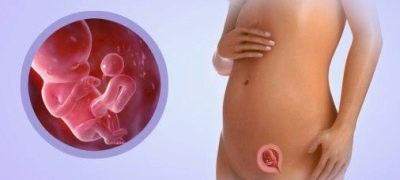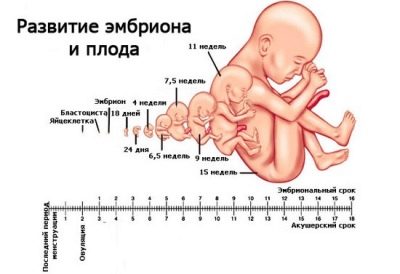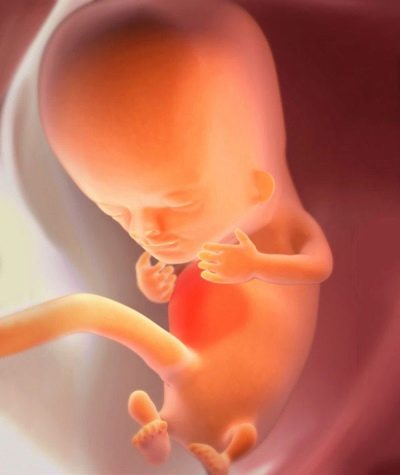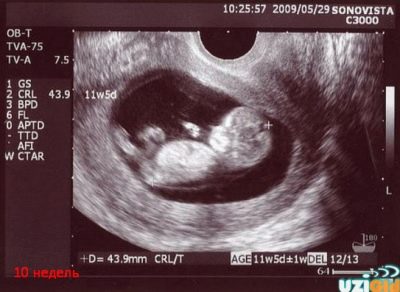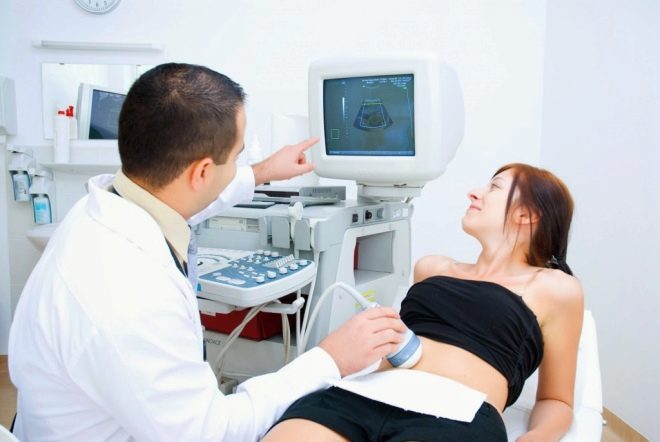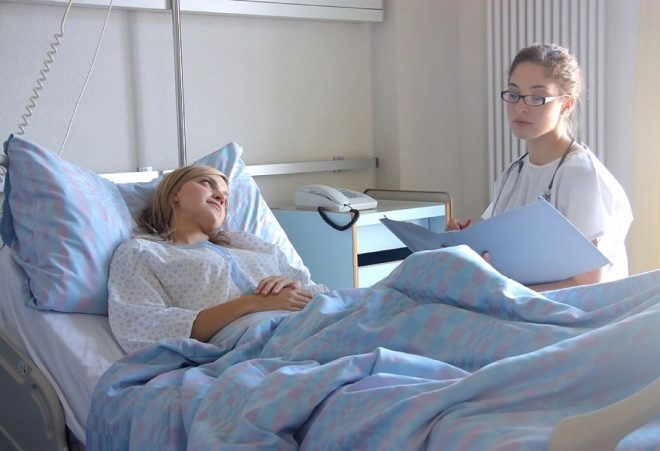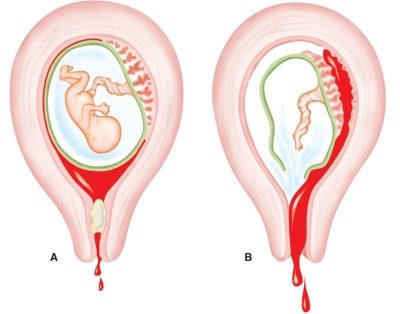10 week of pregnancy: what happens to the fetus and the expectant mother?
10 week gestation is an amazing time. It is during this period that incredible metaformoses occur with the baby and his mother. Every day of this week inside the pregnant woman undergo intensive processes, repeating the whole process of evolution. In this article we will tell about this term in more detail.
How many months is it
9-10 obstetric week, which will be discussed, may be regarded by women differently. Those who are counting on ovulation as the estimated date of conception of the baby are now at week 8. It was 8 weeks or two lunar months that have passed since the meeting of the mother egg and the father spermatozoon.
In the antenatal clinic, where the expectant mother is likely to have already applied for registration or intends to do so in the coming days, the deadline will be indicated according to the tradition, commonly used in medical obstetric practice from the first day of the last menstruation.
Therefore, 8 weeks of fetal actual life is 10 weeks by obstetric standards. In order not to get confused in terms, it is better to focus on obstetric data, because both the test results and ultrasound norms during the entire pregnancy will be calculated in this way - from the first day of the last menstrual period that preceded the onset of pregnancy. The tenth week is the middle of the third month of pregnancy.
If a woman has passed 10 weeks from the delay, then she should read materials about a different period, because she already has 14 obstetric weeks or 12 weeks from conception.
Baby development
The main event of this week is the change of status. The baby is no longer an embryo. Now he is a fetus, that is how the doctors will call him from now on, since the fetal period of pregnancy has begun. The crumbs now produce their own blood cells. It is already possible to determine his blood type and Rh affiliation.
Your son or daughter weighs about 5 grams and grows very quickly. So, at the beginning of the 10th week, his (or her) length from head to tailbone averages 23 mm, and at the end of this week it is close to 38 mm.
With the change of status, the baby has lost an embryonic tail. Now it is the tailbone. In all other respects, he is more and more like a little man, his appearance changes every day. The overall dimensions of the fruit at this time allow you to compare it with a small plum.
Appearance
Something alien in the image of the child is still preserved. For example, he has a big head. She is the largest part of his body so far, but this week she acquires roundness, ceases to be oval.
Its diameter on this period is more than one and a half centimeters.Now there is an active formation of individual features of the child's face - the mouth is shaped with sponges, the eyes have almost moved to the position they had assumed (previously they were on the sides of the head). Eyes remain closed for centuries, it will not be soon to learn how to open their crumb.
The neck, the formation of which began just a week ago, is already there, and the baby was able to turn his head to the right and left. At week 10, the departments of the nose and the outer ear, the auricle itself, develop. Mimic muscles are weak, but the child actively “trains” them, opening and closing the mouth. On the head on this period, the first hair begins to grow.
Pens and legs can already be seen on ultrasound, if you do the study apparatus with good, high resolution. They have tiny fingers, their nails almost "stood up" in the place allotted to them by nature (they migrated from the palms and the feet, where a week earlier they formed as a seal of the fabric).
The bone system has been actively developing from about this week. Now the need for calcium increases significantly A woman should take care to ensure that there is enough food in her diet that contains this mineral.
The abdominal cavity and the chest cavity have increased, the internal organs no longer protrude beyond the body of the child, a diaphragm is formed this week.
Nervous system
The brain and spinal cord are formed, the network of nerve plexuses and nodes is actively developing. Differentiation occurs in the brain at the 10th obstetric week of pregnancy - now the hemispheres are separated from the cerebellum, formed a week earlier, the medulla is also isolated.
Every minute changes occur in the structure of the brain, its large hemispheres develop. Every day the number of brain cells increases by about a quarter of a million.
The first neural connections begin to form. This process is continuous. The nervous system is one of the few in the body, the formation of which takes place not only in the prenatal period, but also for a long time after the birth of the child.
From week 10, the nervous system is already completely divided into central and peripheral. The cerebellum is already formed - it is responsible for the coordination of movements. However, until the coordination is still far away. This week, the baby will learn to hold the handle to the face and very soon realize that you can suck a finger. In the meantime, the sucking reflex is in the formative stage.
Internal organs
The formation of all organs by week 10 is almost complete. Now each of them "masters" the range of its own functional capabilities. The heart of a child has an atrial septum, it works confidently, rhythmically. The heart rate characteristic of this period is 170 beats per minute. Variations from 160 to 179 shocks are permissible.
The child has a thyroid gland this week, hones the kidneys and the bladder with its “skills”, urine is already accumulating in the kidneys and brought out into the amniotic fluid. The composition of the water remains sterile, because they are updated every 3-4 hours.
This week the esophagus is separated from the trachea, now it will connect the oral cavity and the stomach, and the baby’s digestive organs will begin to “rehearse” their work.
What can do baby?
At week 10, the baby learns to bend and unbend limbs. There is a lot of space in the uterus, it feels free in it. If the legs touch the wall of the fetal bladder, the crumb can push off from it and swim in another direction. From day to day, the baby will learn to distinguish taste, because right now on its tongue taste buds are forming receptors.
By the end of this week, the thin and almost transparent skin of the fetus will become sensitive due to the formation of nerve endings on it. From this point on, the baby will begin to "accumulate" the experience of tactile sensations.
What can be seen on the ultrasound?
Ultrasound scanning in this week is not considered mandatory, but may well be carried out for medical reasons or on their own will pregnant. In the uterus, the number of fetuses is determined if the pregnancy is multiple.
In children, vital activity is recorded - heartbeat and movement. An ultrasound scan may be necessary if the doctor needs to clarify the gestational period, because the first prenatal screening is about to take place, which should be carried out at strictly designated time points (from 10-11 to 12-13 weeks inclusive).
Also, ultrasound is recommended at 10 weeks for women who have certain complications - the threat of miscarriage, suspicion of intrauterine growth retardation, etc. Particularly curious future mothers go to the diagnostician just to see how the baby has become, how he has grown.
This week, the duration of pregnancy and the compliance of the baby with it are judged by such parameters as the average inner diameter of the ovum (SVD) and the coccyx parietal size (CTE). Women who are going on an ultrasound scan this week will be interested in what indicators are considered normal for this period.
The average internal diameter of the ovum on week 10
Gestational age | SVD, mm |
9 weeks + 1 day | 36-37 |
9 weeks + 2 days | 38 |
9 weeks + 3 days | 39 |
9 weeks + 4 days | 40-41 |
9 weeks + 5 days | 42 |
9 weeks + 6 days | 43 |
10 weeks exactly | 44 |
Kopchiko-parietal size on the 10th week of pregnancy
Duration of gestation (weeks and days) | KTR of norm, mm | KTP range of permissible values, mm |
9 +1 | 23,7 | 18,6 — 28,8 |
9 +2 | 25 | 19,9 — 30,2 |
9 +3 | 26,4 | 21,2 – 31,6 |
9+4 | 27,8 | 22,5 — 33,1 |
9+5 | 29,2 | 23,8 — 34,6 |
9+6 | 30,7 | 25,2 — 36,1 |
10 weeks exactly | 32,1 | 26,6 — 37,6 |
The yolk sac, which has practically passed all its responsibilities for feeding the baby and the synthesis of hormones, the young placenta, begins to decrease. At week 10, its size is approximately at the level of 5 mm.
The thickness of the young placenta at this time can also be measured for the first time. Its normal size for this period is about 13 mm., but other values that are in the range from 9 to 17 mm will be considered quite normal indicators.
Child sex
Gender crumbs defined. It is already developing either in the female or in the male type. This week continues the formation of external genital organs from the genital tubercle, which looks the same in boys and girls. therefore there is no point in asking during the ultrasound about what sex the baby is. Even a very experienced diagnostician will not be able to answer this question until he sees external sexual signs, and this will only happen closer to the 16th week of pregnancy.
It is theoretically possible to consider sex at 12-13 weeks, but not a single doctor can guarantee the accuracy of this “prediction”: the genitals are too small, and the boy can be easily confused with the girl and vice versa.
The method of determining gender by heart rate is not one of the scientifically based ones. Gender does not affect the work of the cardiovascular system.
Feelings of the future mother
Feeling pregnant this week may begin to stabilize. If earlier tormented by toxicosis, but now its manifestations and symptoms begin to gradually recede, it becomes easier. The size of the uterus by this time has increased by more than 2 times its initial value. Now the main reproductive female organ becomes cramped in the abdominal cavity, and a woman can begin to feel something new from this week. This feeling of fullness in the pelvic area.
The uterus is still in the pelvis, it is already becoming crowded, it begins to rise above the pubic joint. A woman begins to experience more frequent urge to urinate. The rest of the sensations of the woman is still quite light and not burdensome.
The uterus weighs about 150 grams, if the first pregnancy, with the second pregnancy and each subsequent uterus at this time is somewhat heavier - about 230 grams.
Due to an increase in the amount of blood circulating in the body, there may be bouts of dizziness. If they are not accompanied by loss of consciousness, do not occur too often, there is no reason to worry. Under the action of progesterone, a hormone that is produced in large quantities, sleep may be disturbed, while the woman is having trouble falling asleep at night, as a result she feels weak during the day.
Nature so arranged that at the very beginning of pregnancy, when the fetus is most vulnerable, the woman’s sleep becomes more disturbing and sensitive, she “guards” the child around the clock.
Many expectant mothers complain of nightmarish dreams this week of pregnancy. All the processes that are now taking place in the body require considerable energy expenditure, so the feeling of fatigue, fatigue still accompany the pregnancy for a 10-week period, but soon the body can “compensate” for the lack of energy, and in the second trimester, which is not far off , the future mother's state of health will be noticeably better.
Some women this week complain that from time to time they pull their lower abdomen. This has a completely physiological and natural reason - the ligaments that hold the growing uterus begin to stretch, this is exactly what causes the not very pleasant sensations.
The weight gain for this week is between one and a half and two and a half kilograms, but the woman wants to eat almost constantly - this is how the hormone progesterone manifests itself, one of the tasks of which is to create reserves in the maternal organism for food and energy metabolism of both the woman and her baby If you blindly follow the "instructions" of progesterone, the increase may be more, but it will be considered pathological.
The mood of the future mother begins to “level off”. If earlier it was unstable, with frequent differences and contrasting reactions, now the woman is beginning to find a certain calm, although it is still far from this quiet time.
At the 10th week, the possibility of miscarriage still remains, the risks are no longer as great as a few weeks ago, but they exist, and this thought does not give many expectant mothers the opportunity to relax and enjoy their position to the fullest.
Many pregnant women in this period suffer from a cold, the causes of which cannot be established. The woman did not get sick, did not catch a cold, she does not have the flu and ENT diseases, and nasal breathing is still difficult. This happens at the end of the first trimester quite often.
The true cause of pregnancy rhinitis, as experts call it, lies in hormonal changes. Progesterone stores in vain not only fatty tissue, but also water. Excess moisture can build up in tissues. This is what sometimes leads to early preeclampsia, and quite often - to the occurrence of edema of the nasal passages, to the common cold.
Changes in the body
On the physical level, rounding of forms becomes noticeable. Visually, the woman, of course, still does not look pregnant, but the tummy is somewhat rounded due to the fact that the uterus begins to rise above the bosom.
In addition to nice roundness, the growing uterus often causes less pleasant sensations this week - it squeezes the great blood vessels. This leads to the appearance of hemorrhoids, which can deliver a lot of painful and unpleasant sensations.
It is not recommended to treat it yourself in any case, because the drugs that can now be used without the risk of harming the baby are very few - the doctor should choose a specific remedy. Women should eat in such a way as to prevent constipation.
Waistline begins to smooth out. But the envy of all the breast acquires stunning shapes and sizes. It increases by about 1-2 size, looks "poured", elastic. This week may appear in the nipple area small bumps, which are called Montgomery nodules.
On the stomach of many, by the 10th week, a darker vertical than the rest of the skin appears, a vertical strip that appears due to the enhanced melatonin synthesis in the body. After birth, the strip will disappear, and the breast will acquire the same size.
Now the breast can disturb the future mother quite strongly. She is actively preparing for the upcoming breastfeeding, glandular tissue grows.
Pain, burning, aching and itching in the mammary glands bring many to almost a nervous breakdown. There is practically no way to alleviate this condition, you need to be patient and wait a little longer - by the second trimester, the chest will practically cease to hurt, since all the most large-scale reorganizations in the mammary glands take place in the first third of the infant's term.
In the meantime, it is worthwhile to take care of acquiring a comfortable and large bra, you can immediately choose a model for pregnant and lactating women - with special pockets on the inside of the cups for chest pads. You may have to update your wardrobe - your hips are wider, your waistline is bigger, clothes should now be comfortable and practical, not constricting the abdomen and not holding down movements.
At the hormonal level, all processes in a pregnant woman's body at 10 weeks are still controlled by progesterone, estrogens and hCG - human chorionic gonadotropin. HCG begins to be synthesized by the chorion cells immediately after the blastocyst attaches to the uterine cavity (7-9 days after conception).
Now the concentration of hCG is nearing its maximum. It will grow to 12 weeks, and then gradually begin to decline. Now its concentration is in the range of 20900-291000 mU / ml. The rate of progesterone for this period is 23-27.6 ng / ml.
This hormone is necessary for the child to create the best conditions for growth and development. Lack of progesterone increases the risk of spontaneous abortion.
In a woman's body, progesterone is now "responsible" for mood swings, accumulation of fat and water, and appetite. This hormone controls the viability of the uterine muscles and placenta, does not allow the cervix to open up early, and the uterine muscles to contract, keeping them relaxed.
However, due to such hormonal effects, many expectant mothers look great at 10 weeks - their skin becomes smoother, delicate, clean, acne-free, an amazing, peculiar only to pregnant women, mysterious shine appears in the eyes, a woman becomes prettier.
Pain - physiological and pathological
Small abdominal pains in this period may be quite normal. They do not differ sharpness and force, are pulling in nature, are not permanent. Such pains are associated with the functional features of pregnancy of this period - the uterus is constantly growing, this growth does not stop for a minute, muscles and ligaments stretch.
It is necessary to sound the alarm when the pain in the abdomen is accompanied by strange, atypical secretions, is cutting, localized in the lower abdomen, gives in the lower back and in the rectal area. With such a pain can not be tolerated.
You should take a horizontal position, limit motor activity and call an ambulance, because such pains can be signs of a threat of miscarriage or a miscarriage that has begun.
The loin and back at 10 weeks hurt from time to time and in fact there is nothing wrong with that. The load on all muscles under the action of relaxing progesterone increases, the pelvic bones begin to prepare in advance for the upcoming labor, so there may be discomfort in the tailbone area.
The tailbone, the back and the loin do not hurt all the time, but only when the woman is upright for a long time, sits in the same position. To remove unpleasant sensations, you should warm up, walk, lie down a bit, change body position. .
Most often the back and loin begin to hurt in the late afternoon, after a busy day. Many women say that at week 10 a headache. This pain should alert and make the pregnant woman more attentive to her health and all changes. The amount of blood with the advent of the placenta has become more, the pressure on the walls of blood vessels has increased. If earlier a woman had a tendency to increase blood pressure, now you need hard control over his level - you should measure the pressure every day on two hands.
If headaches appear on the background of completely normal blood pressure, they are connected with hormonal changes. It is necessary to suffer a little, hormonal background will begin to change very soon, headaches will recede.
Progesterone in large quantities, alas, does not contribute to normal digestion. Constipation, diarrhea, increased gas formation, indigestion - all these symptoms are well known to pregnant women. Pain can also be caused by eating disorders. Do not confuse them with pregnancy complications.
Abdominal pains due to problems with the digestive organs are of a different nature - they are most often concentrated in the upper abdomen, a woman may have a feeling that the “belly turns”, pain syndrome may be cutting in the right or left side and be accompanied by a feeling of bowel distention .
The causes of pathological pain, in which a woman needs medical care, may be as follows:
- Risk of miscarriage - pains, aggravated, concentrated in the lower abdomen, radiating to the lower back, back, rectum. Accompanied by secretions.
- Ectopic pregnancy - The pain is sharp, strong, unbearable, accompanied by nausea, loss of consciousness, blood discharge from the genitals.
- Exacerbation of chronic diseases - a woman can aggravate against the background of the load on the whole body pyelonephritis, urolithiasis, osteochondrosis, gastritis, colitis, if earlier she had them.
It is clear that it is difficult for a woman herself to understand whether her pain is normal or pathological at such an early period.
Therefore, with the appearance of pain, localized in any part of the body, especially in the back and abdomen, you should contact your doctor and consult with him about the causes of pain and ways to reduce it.
Allotment
Normally, discharge at obstetric week of pregnancy somewhat increases quantitatively. This is due to the fact that the uterus begins to go beyond the pelvis. However, the qualitative features of the vaginal discharge should be the same as before - light, white or milky, as well as yellowish, odorless and impurities. Selection of any other color or shade are considered abnormal and are the reason for going to the doctor.
Green discharge bubbling with an unpleasant fishy smell may indicate the presence of an infection of bacterial origin. Different shades of green vaginal secretions give staphylococcus, gonococci and E. coli.
White thick and viscous discharge, having a cheesy structure and consistency, indicate that a woman has thrush and colpitis. With a bacterial infection and thrush, a woman often has itching, burning, and discomfort in the perineum.
The blood in the discharge can manifest itself in different ways. It all depends on the pathology and the amount of blood. Thus, the discharge can be pink, orange, mucous with streaks of blood, succinic watery or pure blood.
Brown "daub" - is also one of the options for the presence of blood in the genital tract. Such discharge may be a sign of threatening miscarriage, placental abruption, pathologies on the part of the cervix. Therefore, any hint of the presence of blood in the discharge, even if it is clearly not visible, should be regarded by the woman as an excuse for immediate medical attention.
In some women (this happens quite rarely) normal bloody discharge occurs. For example, on the day when regular menstruation arrived outside of pregnancy, a drop of blood could be seen on the daily pads at week 10.
You need to talk with the doctor about this, but if this woman has such a peculiarity, then she should be prepared for the fact that all 9 months, while she is carrying the child, the organism “by old memory” will bleed on the day of the month. Essentially will not happen. Harm for the baby and mother is not a phenomenon. Science convincingly explain it so far failed.
Yellow discharge, accompanied by itching and discomfort at this time, may indicate the presence of a genital infection. Gray and brown discharge most often speak of the inflammatory process of the reproductive organs of a woman. Do not hesitate to consult a doctor.
Discharges are an important diagnostic feature. Any infection of the genital tract, inflammatory process can be a factor in the death of the baby, its intrauterine infection.
Modern medicine has a sufficient arsenal of tools and methods for treating them even during the period of bearing a child.
Possible problems and dangers
The period of heightened danger has not yet ended; to say that the threats for the baby and his mother have passed before it is too early. The baby now needs maternal protection, organogenesis (the formation of all organs) is complete, but the immune system is not working yet, and therefore any negative factor can affect the crumbs.
We will tell about the most frequent hazards that may lie in wait for a pregnant woman at week 10 by obstetric measures.
Retrochorial hematoma
Such a pathology at week 10 is not detected as often as in earlier periods, but it is not excluded. She represents accumulation of blood between the chorion and fetal membranes. This becomes possible if there is a detachment. Retrochorial hematoma is most often found in pregnant women who have unprotected infectious diseases, who have had flu, a cold, and an acute respiratory viral infection in earlier periods.
Often, such a diagnosis on the results of ultrasound can put women who have chronic inflammatory diseases of internal genital organs.
Detachment with the formation of a hematoma may occur when lifting weights, exposure to strong vibration, in violation of hormonal levels, with strong and prolonged stress. If a pregnant woman can not give up bad habits (smoking, alcohol intake), then the probability of developing such a hematoma increases tenfold.
Very often, the retrochorial hematoma develops in women who have suffered from a strong early toxicosis with vomiting and loose stools.
Symptoms in pathology may not be, then it will become apparent on ultrasound. Sometimes a hematoma appears pink or brownish secretions from the genitals. The main danger is further detachment and fetal death in the event that the hematoma increases.
The treatment is carried out in a gynecological hospital, if the hematoma is quite impressive in size, or at home, if it is small. A woman is shown hemostatic drugs, agents that do not allow improving the tone of the uterus, vitamins and complete rest before resorption of the hematoma.
Projections depend on the size of the cavity filled with blood. In most cases, pregnancy can be maintained.
Toxicosis
Strong toxicosis, which is manifested by the physical inability to fully eat, vomiting and indigestion, at 10 weeks - the phenomenon is not so frequent. Now toxicosis is already quite a serious danger - the child every day requires more and more nutrients, vitamins, minerals for further growth. Therefore, a strong toxicosis, which did not pass or did not decrease until 10 weeks, is best treated in the hospital.
A woman who cannot fully eat because of nausea and vomiting will be given intravenous vitamin solutions, drugs that will improve uteroplacental blood flow.
In all other cases, the woman is recommended to eat a little, but often so that the baby does not “starve”. Soon, the symptoms of toxemia should subside, for most, this is already happening, for the rest, relief comes before 12-14 weeks of gestation.
Fading Pregnancy
An embryo is a pregnancy in which the fetus, for whatever reason, stops growing, developing and dying. The irreparable can happen at any time of gestation, however, there are periods during which fetal fading is considered the most likely. The tenth obstetric week refers to such periods.
The risk of sudden death of the baby is highest at 3-4 weeks, from 8 to 10 weeks, and from 16 to 18 weeks of pregnancy.
The reasons for which the baby ceases to develop, medicine is not completely clear. The most likely is the genetic version.. During conception, chromosomal pathologies, triplody, could arise, because of which, during the development of a child, pathologies incompatible with life developed during the development even at the embryonic stage. It can not grow further, the genetic error is total and insurmountable.
Other causes include infectious diseases of the mother, pathological forms of spermatozoa (teratozoospermia) in the father, various adverse factors - ecology, poisons, toxins, radiation, some medications, bad habits of the future mother, a large number of abortions in her gynecological history.
At week 10, this pathology may not manifest in any way until the gynecological examination. The uterus of the woman lags behind the deadline in size, which is the basis for the appointment of an unscheduled ultrasound. The diagnostician states the lack of vital activity of the fetus - it does not have physical activity and does not knock the heart.
After 2-4 weeks after its death, the fetus may begin to reject, then the first symptoms will be spotting bleeding brown and pulling pain in the lower abdomen.
At an earlier stage, a woman could theoretically guess that something had gone wrong. Many claim that they felt that all the pre-existing symptoms and signs of pregnancy had completely disappeared on one “beautiful” day, their chest stopped aching, their basal temperature had decreased.
The uterus is subject to mandatory curettage. Fetal tissue samples are taken for genetic analysis to try to establish exactly what causes led to the tragedy.
This information is needed in order to start planning for the next pregnancy after anti-inflammatory treatment, but already adjusted for the possible risks.
Risk of miscarriage
According to statistics, the threat of abortion manifests itself in the early stages in about 7 out of 10 pregnant women. But these data should not greatly upset the future mother, because in 90% of all cases, doctors quite successfully manage to cope with it and save the baby. Exceptions are cases of threat arising from genetic pathologies. If a baby is not viable by definition, medicine is powerless.
The probability of miscarriage is the higher, the shorter the period of pregnancy. Usually at 10 obstetric weeks, the risks are no longer as great as before.
The most susceptible to miscarriages in this period are women who have had miscarriages earlier this week, as well as women who become pregnant through in-vitro fertilization.
At risk and age moms who are over 35 years old Indeed, with increasing age, the probability of miscarriage in the first trimester is higher.
The threatening condition is manifested by the appearance of pain in the lower abdomen, untypical for this week, discharge from the genital organs, as well as a deterioration in general well-being.
Analyzes and surveys
The list of tests and examinations at week 10 depends on when a woman is registered for pregnancy at the antenatal clinic. If she did this before the onset of 10 weeks, now she can relax and tune in to the first prenatal screening, which can be scheduled for the next week or two weeks later.
If the expectant mother has not yet registered, this week is the time to do it in order to have time to prepare for the screening study.. When registering a woman passes a full and detailed examination. She will be given directions at the first referral to the gynecologist, and she will undergo tests and undergo diagnostic tests throughout the week.
The mandatory analyzes for registration include:
- general blood and urine tests;
- blood chemistry;
- urine bakposev;
- blood tests for HIV status and syphilis;
- a blood test for hepatitis B and C;
- blood tests for the determination of antibodies to chickenpox, cytomegalovirus, rubella, herpes - the so-called TORCH infections;
- blood tests to determine infections, including hidden ones (chlamydia, mycoplasma, etc.);
- a blood test to determine the blood group and Rh-affiliation, if a woman has Rh-negative blood, then an additional venous blood test is made for the presence of non-specific antibodies that may indicate the beginning of the mother-fetus Rh-conflict;
- smear of vaginal contents and scraping from the cervix;
- coagulogram - determination of blood clotting factors;
- colposcopy.
This week, women can be given the day of the first prenatal screening, in which they take a blood test for hCG and plasma protein PAPP-A, and also do an ultrasound of the fetus. The objective of this study is to identify women at risk for genetic abnormalities of the fetus.
Refuse to pass this survey is not worth it.
Recommendations to expectant mothers
Avoiding many complications in week 10 will help to follow the recommendations of the doctor and follow simple rules.
Mode
A woman needs a full night's sleep, so all night shifts, if work is related to them, should be abandoned, legally pregnant has the right to do so. It is important for a woman to find time during the day in order to lie down and relax a bit. If sleep is disturbed, you should consult with your doctor and together choose an easy sedative sedative on a natural basis.
Hypodynamia - the scourge of Russian pregnant women. Therefore, in the daily routine, you should take time for a short walk in the fresh air. Evening promenades will help to normalize the process of falling asleep and improve the quality of sleep.
Nutrition
At week 10, it is important to eat rationally and fully, eat at least 5-6 times a day, but in small portions, not overeating. A woman should refuse from smoked meat, pickled products, fried, fatty, spicy. The amount of salt is desirable to reduce to 5 grams per day, to avoid the occurrence of edema.
In the diet should be enough fresh vegetables and fruits. - It is useful for the baby and is an excellent prevention of constipation and the appearance of hemorrhoids.
It is undesirable to drink carbonated drinks, there is a lot of sweet - it will help eliminate the likelihood of onset of gestational diabetes.
Do not forget that with 10 weeks dramatically increases the need for calcium. A sufficient amount of dairy products, cottage cheese, fresh herbs and nuts must be introduced into the diet.
Sex
At week 10, there are no obvious contraindications to an intense intimate life. Limit sexual activity should be only in case of detection of threatened abortion and for the duration of treatment of identified infections of the genital tract.
If the pregnant woman is healthy, the doctor has no concerns about the condition of the baby and the mother, then sex will only benefit. - it helps a woman to improve her mood, improves blood circulation in the pelvic organs.
The stomach at this time does not interfere yet, it is no longer necessary to protect oneself, the woman’s sexual attraction is at a high enough level, and therefore this week’s intimate comfort can give both partners a lot of pleasure.
Sport
Excessive physical exertion at this time is not welcome, since they can lead to abortion, but swimming will benefit.
If a woman has not been engaged in it before, it's time to enroll in a special group of aqua aerobics for pregnant women, to do yoga. This will help avoid weight gain, as well as prepare the muscles of the female body for the upcoming labor.
Vitamins
Vitamin complexes, created specifically for pregnant women, will help to compensate for the shortage of those or other nutrients in this period. True, experts caution pregnant women from self-assigning vitamins.
All complexes are different in composition, and an excess of a particular vitamin is no less harmful than its lack.
The doctor will help you choose a drug based on the results of a biochemical blood test that shows which vitamins and minerals and how much is contained in the blood of the future mother.
Reviews
Mothers' reviews about the 10th week of pregnancy mainly concern the issues of new sensations that the growing uterus causes. Many say that it became uncomfortable to lie on your back, to sit for a long time at the workplace. Suddenly, at this time women come to the idea that it is time to change their wardrobe - all belts and elastic bands begin to “press”.
Some of the expectant mothers are already taking pictures of their rounded tummies. Basically, "tums" are beginning to appear on this period in thin girls. Most mothers by this time have already visited the ultrasound.
Every disturbing thought, and in pregnant women they appear often, can be a reason to check, “is everything okay with a crumb”. Excessive exposure to ultrasound is not welcome because The effect of ultrasound radiation on the fetus is not fully understood.
About what happens to the fetus and the expectant mother in the 10th week of pregnancy, see the following video.

